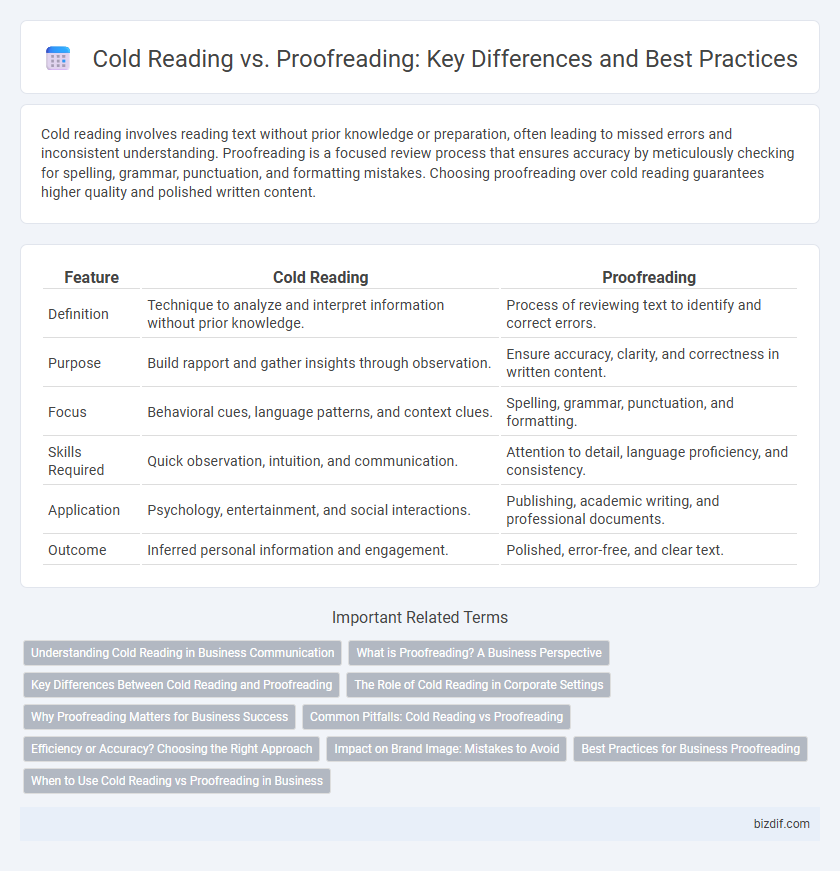Cold reading involves reading text without prior knowledge or preparation, often leading to missed errors and inconsistent understanding. Proofreading is a focused review process that ensures accuracy by meticulously checking for spelling, grammar, punctuation, and formatting mistakes. Choosing proofreading over cold reading guarantees higher quality and polished written content.
Table of Comparison
| Feature | Cold Reading | Proofreading |
|---|---|---|
| Definition | Technique to analyze and interpret information without prior knowledge. | Process of reviewing text to identify and correct errors. |
| Purpose | Build rapport and gather insights through observation. | Ensure accuracy, clarity, and correctness in written content. |
| Focus | Behavioral cues, language patterns, and context clues. | Spelling, grammar, punctuation, and formatting. |
| Skills Required | Quick observation, intuition, and communication. | Attention to detail, language proficiency, and consistency. |
| Application | Psychology, entertainment, and social interactions. | Publishing, academic writing, and professional documents. |
| Outcome | Inferred personal information and engagement. | Polished, error-free, and clear text. |
Understanding Cold Reading in Business Communication
Cold reading in business communication involves interpreting unfamiliar information quickly without prior knowledge, relying on intuition and context clues to gauge the message's intent. Unlike proofreading, which focuses on identifying and correcting errors in written content, cold reading emphasizes real-time analysis of verbal and nonverbal signals to enhance interpersonal understanding. Mastery of cold reading skills helps professionals navigate meetings, negotiations, and presentations more effectively by anticipating needs and responses.
What is Proofreading? A Business Perspective
Proofreading in a business context involves meticulously reviewing written content to identify and correct errors in grammar, spelling, punctuation, and formatting. This process ensures that documents such as reports, proposals, and marketing materials maintain professional quality and clarity, reinforcing a company's credibility. Unlike cold reading, which is a quick, initial evaluation of text, proofreading demands focused attention to detail and accuracy to uphold brand standards and effective communication.
Key Differences Between Cold Reading and Proofreading
Cold reading involves interpreting and understanding text without prior exposure, relying heavily on intuition and context clues, whereas proofreading is a meticulous review process aimed at identifying and correcting errors in grammar, spelling, punctuation, and formatting. Proofreading requires focused attention to detail and a systematic approach to ensure textual accuracy, while cold reading prioritizes quick comprehension and immediate interpretation. The key difference lies in cold reading's emphasis on real-time understanding compared to proofreading's goal of error detection and textual refinement.
The Role of Cold Reading in Corporate Settings
Cold reading in corporate settings enhances real-time communication by enabling professionals to quickly interpret colleagues' or clients' unspoken cues and intentions without prior knowledge. This skill supports decision-making and negotiation by fostering immediate understanding, contrasting with proofreading's focus on meticulous review of written content for accuracy and clarity. Integrating cold reading with traditional proofreading optimizes overall corporate communication efficiency through both verbal and written channels.
Why Proofreading Matters for Business Success
Proofreading ensures accuracy and professionalism in business communications, preventing costly errors that can damage a company's reputation. Unlike cold reading, which involves interpreting text without prior familiarity, thorough proofreading carefully checks for grammatical mistakes, typos, and consistency. This process enhances credibility, fosters trust with clients, and ultimately supports successful business outcomes.
Common Pitfalls: Cold Reading vs Proofreading
Cold reading often leads to misinterpretation and overlooked errors due to its reliance on initial impressions without thorough review, whereas proofreading demands careful examination of grammar, punctuation, and syntax to ensure accuracy. Common pitfalls in cold reading include missing contextual nuances and subtle mistakes, while proofreading errors frequently arise from fatigue and lack of focus. Prioritizing systematic proofreading techniques helps avoid these issues by promoting meticulous, accurate text analysis.
Efficiency or Accuracy? Choosing the Right Approach
Cold reading offers speed by providing a quick initial assessment of a text, often identifying obvious errors and inconsistencies. Proofreading delivers higher accuracy through thorough examination, catching subtle mistakes in grammar, punctuation, and style. Selecting between cold reading and proofreading depends on whether the priority is rapid content review or meticulous error correction for polished quality.
Impact on Brand Image: Mistakes to Avoid
Cold reading often leads to overlooked errors that can damage a brand's professional image, resulting in customer distrust and reduced credibility. Proofreading ensures accuracy and consistency, safeguarding the brand's reputation by preventing typographical, grammatical, and factual mistakes. Avoiding errors through meticulous proofreading strengthens brand trust and enhances overall market perception.
Best Practices for Business Proofreading
Effective business proofreading demands meticulous attention to detail, unlike cold reading which relies on initial impressions and assumptions. Best practices include reviewing text multiple times, reading aloud to catch errors, and using digital tools to identify overlooked mistakes. Establishing a standardized proofreading checklist ensures consistency and accuracy in all business communications.
When to Use Cold Reading vs Proofreading in Business
Cold reading is useful in business when quick, initial reviews of documents or presentations are needed to gauge general understanding or emotional impact before final edits. Proofreading is essential for thorough, detailed examination of text to catch spelling, grammar, and formatting errors, ensuring professional and polished communication. Prioritize cold reading for early feedback during drafts and proofreading for final version accuracy and clarity in business communications.
Cold Reading vs Proofreading Infographic

 bizdif.com
bizdif.com